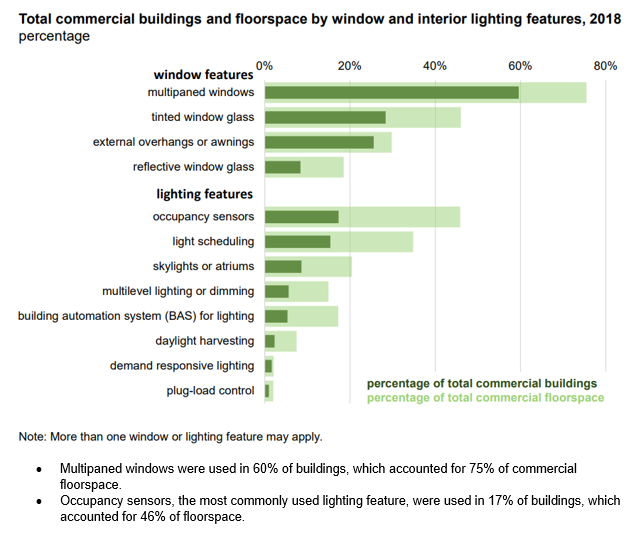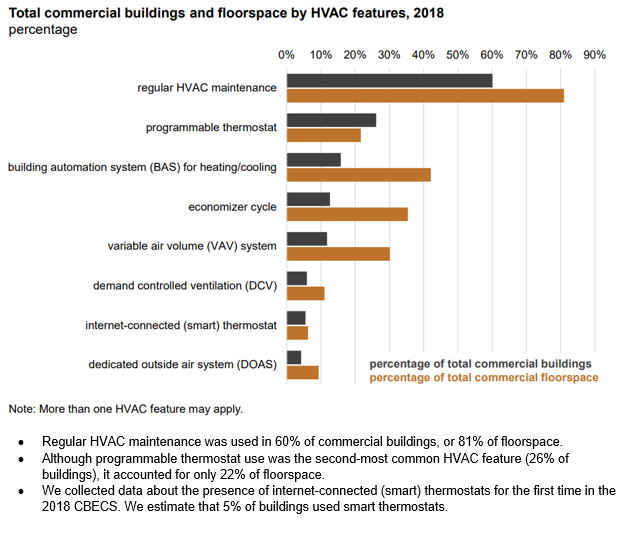Building owners are learning how they can cut emissions or even go net-zero while at the same time reducing energy costs. Electricity generated from fossil fuels and natural gas poses a significant environmental threat. And though there is a lot of talk about converting to renewable energy, there isn’t enough time spent considering the benefits of investing in energy-efficient business operations. Yes, converting to renewable sources reduces emissions, but only by investing in energy efficiency can you reduce emissions and energy costs.
The current rate of Greenhouse Gas (GHG) energy usage in commercial buildings is startling, with 16% of 2020 greenhouse gas emissions (CO2e) attributed to electricity and natural gas usage. Furthermore, the Commercial Buildings Energy Consumption Survey (CBECS) estimated that commercial buildings consumed 1.28 trillion kWh of electricity, representing 35% of the electricity consumed in the United States at $0.11per kWh. This translates into a staggering $141 billion spent on electricity while generating over 600 million tons of CO2e.
The primary sources of CO2e emissions from buildings are 1) computers and office equipment, 2) office lighting and 3) heating and cooling. For buildings with onsite refrigeration, HFC refrigerant R-410a and electricity are the primary sources of CO2e.
By understanding the sources of CO2e, building owners can take action to decarbonize while stimulatingly reducing costs. Building owners can accomplish decarbonization in two ways:
- Buildings can convert to renewable energy, or
- They can invest in energy-efficient strategies.
Converting to Renewable Energy
The U.S. renewable energy market is comprised of three renewable energy options. A building can be converted to renewable electricity with the installation of a renewable energy system such as rooftop solar, or the owner can convert to renewable power from the local utility or purchase renewable energy credits (RECs). By converting to renewable energy, an owner will significantly reduce the building’s CO2e footprint and may even realize a small per kWh saving. Which renewable option is best suited for a particular building depends on many factors, including the possibility of receiving government subsidies or favorable renewable energy pricing. The primary goal of converting to renewable energy is to reduce emissions associated with electricity as it does not change the amount of energy used by a building.
Energy Reduction Strategies
Energy reduction strategies are designed to reduce energy usage, which translates into reducing energy costs and emissions. Energy reduction is the optimal way for a building to reduce its costs and environmental footprint. Additionally, the reduction in energy costs typically finances the required investment, and the benefit (ROI) is measured in its payback period. These strategies are broken out into near-term and long-term strategies.
Near term reduction strategies:
- Install updated lighting fixtures, LED bulbs and occupation sensors
- Upgrade to ENERGY STAR-rated appliances like refrigerators, dishwashers and laundry machines
- Install solar shade window treatments to reduce cooling energy usage
- Paint roof white or another solar reflecting color
Near-term energy reduction strategies are characterized by their low cost and short payback period. The energy cost saving from these initiates can also be used to fund longer-term investments that require more up-front capital and have more extended payback periods.
Long-term investments include:
- Window replacement and overall weatherization of buildings
- Upgraded HVAC systems, including installing indoor controls
- Updated heating systems, including water heaters
- Convert 100% of building utilities to electric
- Install a "Cool Roof" to reduce solar radiation
Long-term strategies typically require significant upfront capital and have longer payback periods but higher ROI. They reduce monthly utility costs, lower a building’s carbon footprint and will likely improve indoor comfort for occupants. They may also reduce maintenance costs and mechanical issues.
Conclusion
Emissions for buildings can be reduced by a building owner either converting to renewable energy or investing in energy-efficient strategies. Converting to renewable energy will only reduce a building’s emissions and will not impact energy usage or costs. Investing in energy efficiency is the only way to achieve both, a significant cost savings while reducing a building’s emission footprint. Ideally, a building owner will do both — converting to renewables and investing in energy-efficient strategies.
Whether a building owner decides to convert to renewables or invest in energy efficiency improvements, the effects of climate change will be reduced. And by doing so, the overall value of the building can increase while costs are lowered simultaneously.
The charts below illustrate the percentage of buildings using the various energy-efficient strategies for windows, lighting and HVAC.


Contact Us
Interested in increasing the value of your commercial investments while saving on operations costs? Contact a member of our ESG Advisory Team today to find out why and how.





